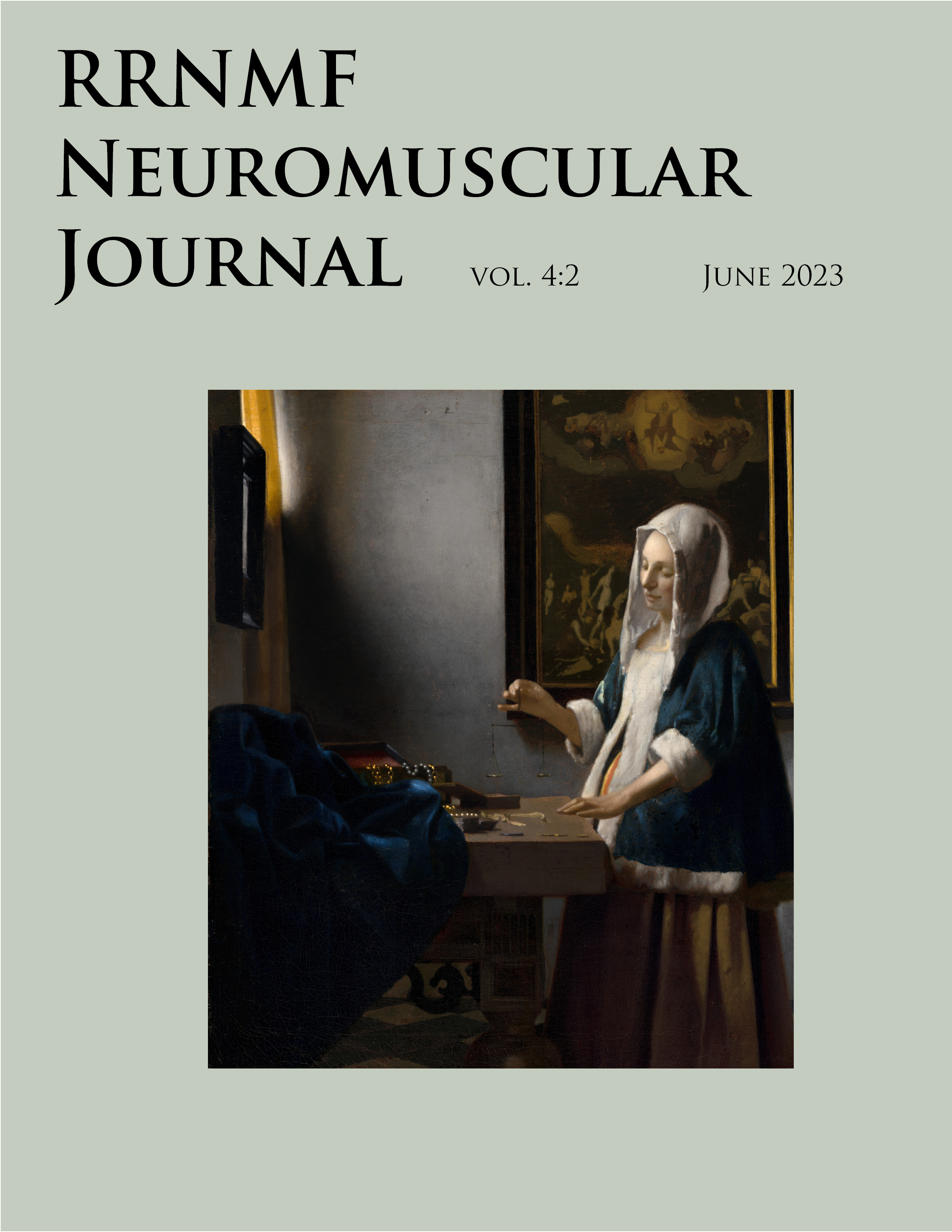Quantitative sensory testing in a large cohort of neuropathy patients
QST in Neuropathy
DOI:
https://doi.org/10.17161/rrnmf.v4i2.19513Keywords:
quantitative sensory testing, QST, cryptogenic sensory polyneuropathy, peripheral neuropathy, cspnAbstract
Background:
Quantitative sensory testing (QST) is a subjective but reliable and quantifiable method to detect patient thresholds to different sensory stimuli. QST is used to measure small- and large-fiber nerve function and can be used in conjunction with other diagnostic modalities in the evaluation of peripheral neuropathy (PN). The utility of QST to distinguish among different types of PN, however, has not been explored. The objective of the study was to evaluate if different patterns of QST abnormalities could distinguish between PN types.
Methods:
This single-center retrospective cohort study evaluated the frequency of QST abnormalities to vibratory, cold and heat detection thresholds in a large population of PN cases evaluated at the University of Texas Southwestern Medical Center peripheral neuropathy clinic between 1995-2000. PN was categorized by etiology.
Results:
A total of 559 QST studies were performed in this study. The average age of patients (n=557) was 60 years with a male-to-female ratio of 1:1. The most common diagnosis was cryptogenic sensory polyneuropathy (CSPN, n=294), followed by Charcot–Marie–Tooth disease (n=84)). Meta-regression of vibration and cold indicate that the expected proportion of abnormal responses is less for the vibration test (p = 0.0002), relative to the cold test. However, no differences were observed between diagnoses.
Conclusions:
Though abnormal QST thresholds were seen in most patients with PN, patterns of QST abnormalities do not distinguish between different types of PN. The routine clinical utility of QST is likely limited.
Downloads
References
REFERENCES:
Fruhstorfer H, Lindblom U, Schmidt WG: Method for quantitative estimation of thermal thresholds in patients. J Neurol Neurosurg Psychiatry 1976;39:1071-1075. doi: 10.1136/jnnp.39.11.1071. PMID: 188989
Shy ME, Frohman EM, So YT, Arezzo JC, Cornblath DR, Giuliani MJ, Kincaid JC, Ochoa JL, Parry GJ, Weimer LH; Therapeutics and Technology Assessment Subcommittee of the American Academy of Neurology. Quantitative sensory testing: report of the Therapeutics and Technology Assessment Subcommittee of the American Academy of Neurology. Neurology. 2003 Mar 25;60(6):898-904. doi: 10.1212/01.wnl.0000058546.16985.11. PMID: 12654951.
Wolfe G.I. Quantitative sensory testing: basic principles and clinical applications. In: Dumitru D., Amato A.A. and Zwarts M.J., eds. Electrodiagnostic Medicine. Philadelphia: Hanley & Belfus, 2nd ed., 2001; pp 429-437.
Wolfe GI, Baker NS, Amato AA, et al. Chronic Cryptogenic Sensory Polyneuropathy: Clinical and Laboratory Characteristics. Arch Neurol. 1999;56(5):540–547. doi:10.1001/archneur.56.5.540. PMID: 10328248.
Wittenberg B, Svendsen TK, Gaist LM, Itani M, Gylfadottir SS, Jensen TS, Gaist D, Sindrup SH, Krøigård T. Test-retest and time dependent variation and diagnostic values of vibratory sensation determined by biothesiometer and the Rydel-Seiffer tuning fork. Brain Behav. 2021 Aug;11(8):e2230. doi: 10.1002/brb3.2230. Epub 2021 Jun 4. PMID: 34087955; PMCID: PMC8413738.
Backonja MM, Attal N, Barohn R, et al. Value of quantitative sensory testing in neurological and pain disorders: NeuPSIG consensus. Pain. 2013;154:1807–1819. doi: 10.1016/j.pain.2013.05.047. PMID: 23742795.
Lehmann, H.C., Wunderlich, G., Fink, G.R. et al. Diagnosis of peripheral neuropathy. Neurol. Res. Pract. 2, 20 (2020). https://doi.org/10.1186/s42466-020-00064-2. PMID: 33324924; PMCID: PMC7650053.
Watson JC, Dyck PJ. Peripheral Neuropathy: A Practical Approach to Diagnosis and Symptom Management. Mayo Clin Proc. 2015 Jul;90(7):940-51. doi: 10.1016/j.mayocp.2015.05.004. PMID: 26141332.
Egenolf N, Zu Altenschildesche CM, Kreß L, Eggermann K, Namer B, Gross F, Klitsch A, Malzacher T, Kampik D, Malik RA, Kurth I, Sommer C, Üçeyler N. Diagnosing small fiber neuropathy in clinical practice: a deep phenotyping study. Ther Adv Neurol Disord. 2021 Mar 23;14:17562864211004318. doi: 10.1177/17562864211004318. PMID: 34335876; PMCID: PMC8283814.
Pasnoor M, Dimachkie MM, Barohn RJ. Cryptogenic sensory polyneuropathy. Neurol Clin. 2013;31(2):463-476. doi:10.1016/j.ncl.2013.01.008. PMID: 23642719; PMCID: PMC4090929.
Hanewinckel R, van Oijen M, Ikram MA, van Doorn PA. The epidemiology and risk factors of chronic polyneuropathy. Eur J Epidemiol. 2016 Jan;31(1):5-20. doi: 10.1007/s10654-015-0094-6. Epub 2015 Dec 23. PMID: 26700499; PMCID: PMC4756033.
Dyck PJ, O'Brien PC, Kosanke JL, Gillen DA, Karnes JL. A 4, 2, and 1 stepping algorithm for quick and accurate estimation of cutaneous sensation threshold. Neurology. 1993 Aug;43(8):1508-12. doi: 10.1212/wnl.43.8.1508. PMID: 8351003.
Devigili G, Cazzato D, Lauria G. Clinical diagnosis and management of small fiber neuropathy: an update on best practice. Expert Rev Neurother. 2020 Sep;20(9):967-980. doi: 10.1080/14737175.2020.1794825. Epub 2020 Jul 23. PMID: 32654574.
Navarro X, Kennedy WR: Evaluation of thermal and pain sensitivity in type-1 diabetic patients. J Neurol Neurosurg Psychiatry 1991;54:60-64. doi: 10.1136/jnnp.54.1.60. PMID: 1849171; PMCID: PMC1014301.
Yarnitsky D. Quantitative sensory testing. Muscle Nerve. 1997 Feb;20(2):198-204. doi: 10.1002/(sici)1097-4598(199702)20:2<198::aid-mus10>3.0.co;2-#. PMID: 9040659.
Ziegler D, Mayer P, Wiefels K, et al.: Assessment of small and large fiber function in long-term type 1 (insulin-dependent) diabetic patients with and without painful neuropathy. Pain 1988;34:1-10. doi: 10.1016/0304-3959(88)90175-3. PMID: 3405615.
Hilz MJ, Claus D, Neundörfer B, et al.: Is heat hypoalgesia a useful parameter in quantitative thermal testing of alcoholic polyneuropathy? Muscle Nerve 1994;17:1456-1460. doi: 10.1002/mus.880171215. PMID: 7969246.
Downloads
Published
Issue
Section
License
Copyright (c) 2023 Alexis A. Lizarraga MD MS, Salman Bhai MD, Gil Wolfe MD, Laura Herbelin BS, Sharon Nations MD, Morgan McCreary PhD, David Saperstein MD, Richard J. Barohn MD

This work is licensed under a Creative Commons Attribution-NonCommercial-NoDerivatives 4.0 International License.

